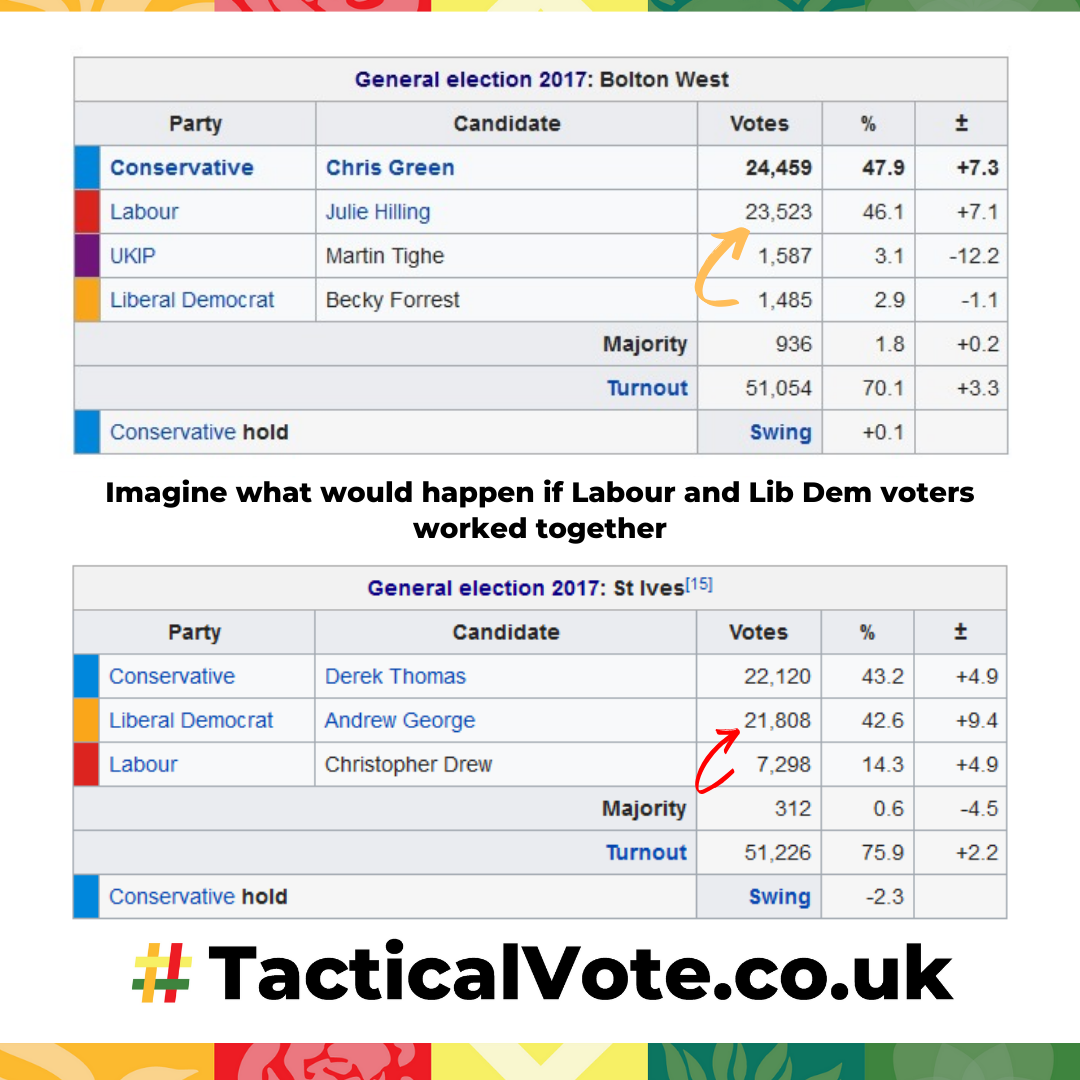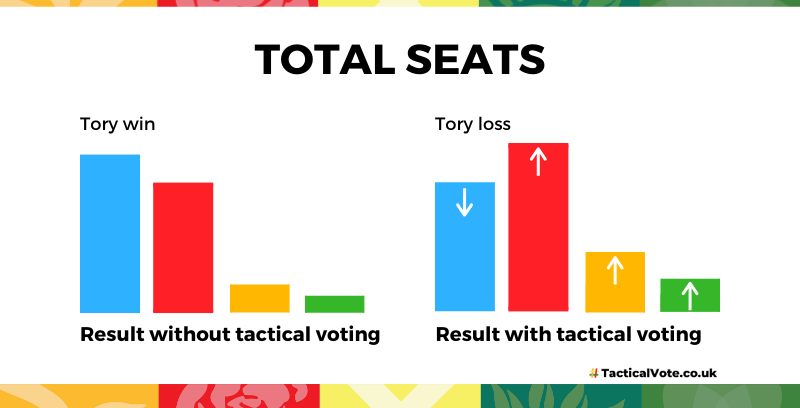What is Tactical Voting? A Guide

To understand tactical voting it’s important to first understand the electoral system used in the UK. The country is split into 650 areas called “constituencies” or “seats” and each one has an MP to represent that area. We use a system called "First Past The Post" (or FPTP) to elect each MP.
On election day, people vote for the candidate they want to win in their area. Most of the time, people will choose a candidate based on which political party they are a member of (such as Labour or the Conservatives). Whichever candidate receives the most votes in that area will win that seat and become an MP. However, each area is quite different and so different parties are more likely to win in different seats.
This is because each area of the UK is quite unique. Some areas may be quite conservative and traditional, whereas others may be quite modern and multi-cultural. In some areas there are a lot of working class families, and in others there may be a lot of middle class families. This means each area is likely to support a quite different mix of political parties. In some, the area votes mostly for one party. These are known as safe seats. In others, there are two parties that have a chance of winning. These are called marginals.
Examples
Thurrock 2017 General Election
Thurrock
Conservative Party win by a margin of 0.69%
Thurrock is a constituency in the East of England. Historically this seat has been closely contested by both Labour and the Conservatives. In 2017 the Conservatives won 39.5% of the vote with Labour on 38.8% in second place. The difference was a mere 345 votes. The Liberal Democrat candidate received 1.6% with 798 votes.
Richmond Park 2017 General Election
Richmond Park
Conservative Party win by a margin of 0.07%
Richmond Park is a constituency in London. Since its creation in 1997 it has returned only Liberal Democrat or Conservative MPs. In 2017 the Conservatives won 45.14% of the vote with the Liberal Democrats on 45.07% in second place. A difference of only 45 votes. Labour received 5773 votes in 3rd place (9.12%).
In both of these constituencies there would have been a different winner if a handful of people had voted for a different party. It would have only taken 46 of those 5773 Labour voters to vote for the Lib Dems instead in Richmond Park for them to change the outcome to a Liberal Democrat seat instead of a Conservative seat. If this had been repeated in the other marginal seats, the outcome of the election could have been completely different.
Here is another example of two marginal seats where Labour voters could have changed the outcome by voting Lib Dem, and Lib Dem voters could have changed the outcome by voting for Labour.

There are many marginal seats where it is important to vote tactically, you can view the closest ones here.
Why should I vote tactically?
There are a number of reasons why you might want to vote tactically for a progressive party (Labour, Lib Dem, SNP, Plaid Cymru, Green). Here are a few of them:
Make your vote count
In many seats, if you don’t vote tactically for a party that has a chance of winning, your vote is essentially wasted. Some people believe it is better to have your vote count for a party you kind of like than have your vote wasted on a party you really like, but has no chance of winning in your seat.
Stopping the Conservatives
If you don’t like the way the Conservatives have been running the country for the last 10 years and don’t want them to continue for another 5, you can vote tactically to try to reduce their overall number of MPs and prevent them from getting into power.
Voting to stop Brexit
If you want to have another say on Brexit or to stop Brexit, the best chance of achieving this is to vote for whichever candidate is in the best position to beat the Conservatives who want to continue with Brexit without offering the people a final say. The progressive parties would support giving the country a people’s vote on the final deal.
You want a Labour government
The best chance Labour have of forming a government is to get more seats than the Conservatives. One method of achieving this is obviously to gain as many Labour seats as possible. But another method is to try to reduce the number of seats the Conservatives win. Doing both of these is the most effective way to a Labour government, and in a lot of seats that means voting Lib Dem in order to prevent a Tory from winning (for example in Richmond Park) as Labour don’t have a chance of winning there.
You want a coalition or minority government
While the Conservatives are so popular compared to Labour, the most likely result to be achieved by tactical voting is a coalition government, or minority government. If Labour are just short of a majority, they could join together with the Greens for example in a formal coalition to achieve a majority. If they don’t have enough for a majority but still have more seats than anyone else, they could form a minority government and join with other parties on an issue by issue basis. For example, they could vote together with Lib Dems and SNP on Brexit. This gives smaller parties like SNP or Lib Dems a lot more power than they would have if there was a Conservative majority government.
Ending austerity, prioritising the NHS, or other similar issues
The progressive parties (Labour, Lib Dem, SNP, Plaid Cymru, Green) all have similar stances on many issues such as ending austerity, prioritising the NHS, increasing free childcare for working parents, and environmental issues. You may wish to vote for whichever progressive candidate has the best chance in your area because they all agree on the issues most important to you.
You don’t want to vote tactically
This one sounds weird but voting tactically could be the best way to avoid ever having to vote tactically again. Many smaller parties are hurt by our current electoral system as the number of votes cast don’t reflect how many seats are won. Most of the time you have to choose between one of two big parties. This is something the Conservatives do not want to change and Labour has mixed views on. But if one of those big parties cannot win a majority and has to rely on smaller parties for their votes, they could strike a deal where they support the large party on one of their policies, in return for reforming the electoral system. Something similar happened in 2010 when the Liberal Democrats were able to persuade the Tories to hold a referendum on the voting system. If we did implement a better voting system where votes were more equal, we would no longer need to vote tactically.
You can also visit Make Votes Matter to get involved with campaigning for electoral reform.
Ready to vote tactically?
All you need is your postcode to find the best Tactical Vote in your constituency.
Does tactical voting work?
Tactical voting works, especially in close marginal seats. Here are some examples:
The Constituency of Stroud in the South West of England has been a close fight between Labour and the Conservatives for decades. 2017 was no exception, with Labour winning on 47% of the vote with the Conservatives second with 46% of the vote. You can see the full results below.
Some of Labour’s votes in 2017 likely came from Liberal Democrat and Green supporters who received fewer votes in 2017 than they had in previous elections. Conversely, Labour won more votes than they ever had before in this seat. Without those Labour votes from the Greens and Lib Dems, the Conservatives would have won here. And if they switch back to Green or Lib Dem in 2019, the Conservatives could win again.
St Ives is also in the South West but shows a different story. This seat swings between the Tories and the Liberal Democrats. In 2017 it was very close with both parties receiving around 22k votes each. The Conservatives won by 312 votes. Labour came third with 7298 votes. It would only have taken a few Labour supporters to vote for the Lib Dems instead of Labour, and in doing so they would have denied the Tories one of their seats.
If tactical voting occurs in all marginal seats, this could be enough to completely change the election result.

Tactical voting in Northern Ireland
Tactical voting in Northern Ireland is slightly different. The political parties themselves often step down for one another in various seats. (This does happen in the rest of the UK, usually by the Green party, but it isn’t usually as widespread) But this hasn't happened in every seat, so it is still important to vote tactically.
How do I vote tactically in my area?
Please share this page to help spread the word about tactical voting.